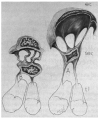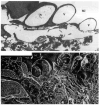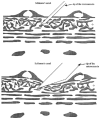'What controls aqueous humour outflow resistance?'
- PMID: 16386733
- PMCID: PMC2892751
- DOI: 10.1016/j.exer.2005.10.011
'What controls aqueous humour outflow resistance?'
Abstract
The bulk of aqueous humour outflow resistance is generated in or near the inner wall endothelium of Schlemm's canal in normal eyes, and probably also in glaucomatous eyes. Fluid flow through this region is controlled by the location of the giant vacuoles and pores found in cells of the endothelium of Schlemm's canal, but the flow resistance itself is more likely generated either in the extracellular matrix of the juxtacanalicular connective tissue or the basement membrane of Schlemm's canal. Future studies utilizing in vitro perfusion studies of inner wall endothelial cells may give insights into the process by which vacuoles and pores form in this unique endothelium and why inner wall pore density is greatly reduced in glaucoma.
Figures








References
-
- Albelda SM, Sampson PM, et al. Permeability characteristics of cultured endothelial cell monolayers. J Appl Physiol. 1988;64:308–322. - PubMed
-
- Allingham RR, de Kater AW, et al. The relationship between pore density and outflow facility in human eyes. Invest Ophthalmol Vis Sci. 1992;33(5):1661–1669. - PubMed
-
- Alvarado JA, Yun AJ, et al. Juxtacanalicular tissue in primary open angle glaucoma and in nonglaucomatous normals. Arch Ophthalmol. 1986;104:1517–1528. - PubMed
-
- Alvarado JA, Murphy CG, et al. Effect of beta-adrenergic agonists on paracellular width and fluid flow across outflow pathway cells. Invest Ophthalmol Vis Sci. 1998;39:1813–1822. - PubMed
-
- Alvarado JA, Betanzos A, et al. Endothelia of Schlemm's canal and trabecular meshwork: distinct molecular, functional, and anatomic features. Am J Physiol Cell Physiol. 2004;286:C621–C634. - PubMed
Publication types
MeSH terms
Grants and funding
LinkOut - more resources
Full Text Sources
Other Literature Sources
Medical

